Disclaimer: Stocks fluctuate widely in prices and are, therefore, risky to trade and/or invest. Past performance does not guarantee future results. When trading or investing, your capital is at risk. Decisions are yours to make. We do not advise to invest nor trade any specific stocks, and can not be held liable for the accuracy of the information below.
A Penny stock is typically the stock of a small company that trades for less than $5 per share. They usually trade outside of the major market exchanges at low prices. Whilst some penny stocks trade on larger exchanges like the New York Stock Exchange, most are traded through Over the Counter (OTC) transactions through the electronic OTC Bulletin Board. With no trading floor, quotations are done electronically.
In the UK, penny stocks are mostly traded on small-cap indexes like the FTSE Small Cap and are often prone to volatile changes. This feeds into their capacity to yield high returns – often up to ten times your money.

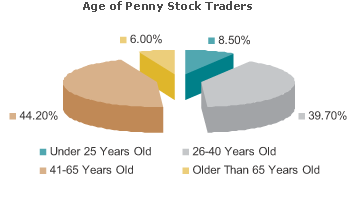
Penny stocks are largely defined as those priced under £1, and in the USA, penny stocks are shares trading at $5. It should be noted early on, that the risk factor is significant with penny stocks. They generally trade infrequently so can be difficult to shift once they’re yours. They are also the subject of some major scams and have limited liquidity. When traded strategically, they can be a lucrative additional stream of income.
Everything You Need to Know About Penny Stocks in a Nutshell
1. They can be risky
Penny stocks tend to carry more risk than regular stocks because of their lower prices per share – the very thing that makes them attractive – and their higher volatility. Keep in mind that these are incredibly speculated investments, and so whilst they might be good for your portfolio, they’re certainly not for everybody.
2. They have limited liquidity
Compared to regular stocks, there is a much lower volume of penny stocks trading hands on a daily basis. With fewer shares being sold, any significant purchase or sale will have an equally significant impact on stock levels. Less volume means investors run the risk of not being able to sell their shares at a desirable price.
3. Small market capitalization
The result of low price per share combined with a low number of shares outstanding has an impact on penny stock’s market capitalisation. Considered ‘micro-cap’ stocks, their market capitalisation is typically in the range of $50-$300 million.
4. They are volatile
Penny stocks tend to be incredibly news-sensitive – meaning extreme price swings can happen weekly and in some cases daily. Professional traders will steer clear of these when it comes to their strong fundamentals. However, they will be inclined to invest in a new product release, like an innovative pharmaceutical drug. As news is released, share prices experience excessive swings. Since most news is now delivered to us in real-time, this can severely affect the stability of penny stocks.
5. They can be manipulated easily
With low liquidity and lack of information comes an inherent susceptibility to price manipulation. That’s those who will first purchase a large quantity of the stock to artificially inflate the price through misleading statements. Scammers have been found to use a range of media platforms to inaccurately promote the next big stock – known as ‘pump and dump’.
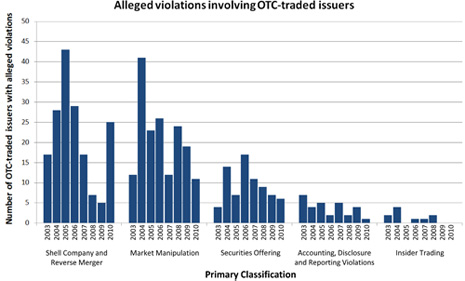
(Market manipulation and other unethical violations. Image: SEC.gov)
6. Lack of information
There are significantly fewer ratios, reports and fundamentals available when it comes to penny stocks. This makes it difficult to make sound investment decisions. The information that is available can be hard to verify and has a history of being from untrustworthy sources.
How do Penny Stocks work?
They ultimately trade like any other stock, but they carry an added risk. The risk is derivative of the fact they’re traded less frequently – making them less liquid, they’re also susceptible to higher price swings – making them a tricky investment for those less experienced.
As a direct consequence of their low price share and smaller market capitalisation, penny stocks are made up of highly speculative and often unproven companies. Receiving less coverage from large institutional investors, penny stocks tend to possess less information; making them tough to become the basis of sound trading decisions.
Unlike regular stocks, penny stocks aren’t required to file with the SEC in the U.S or the FCA in the UK, making the bleak information that is available, less credible. Their reluctance to be liquid decreases the chances of finding a buyer and forces investors to sell them at prices that do not accurately reflect the market.
Who are penny stocks for?
Penny stocks are most suitable for investors who have a high tolerance for risk. That’s because penny stocks that are offered on the market are often those of growing companies with limited cash and resources.
Whilst there is a great chance for investors to lose their entire investment on a penny stock – or worse if they buy on margin – the prosperity of the penny stock comes from their ability to generate a higher potential for reward. That’s, in part, what makes them so attractive.
Penny stock investment tip
Considering the level of risk associated with investing in penny stocks, there are particular cautions to take. For a start, investors should have a ‘stop-loss order’ that is predetermined before entering a trade and know precisely what price to make their exit.

(Stop-loss order. Image: ForexTrainingGroup)
Stop-loss orders are those given to the broker that lays out a price limit – that once reached, triggers an automatic sell of the assets.
Tiers of penny stocks
Stocks are sorted into tiers based on the amount of information that a company is willing to share with the public and penny stocks are no different. These tiers are valuable indicators that should guide penny stock investment to some degree.
Tier 1: The penny stocks listed on major stock exchanges. They are most typically priced at below $5 or £1 in the UK but can sometimes teeter over the edge. They are held to high standards relative to OTC penny stocks and so are less open to manipulation.
Tier 2: The most traditional of the penny stocks, typically priced between one and 99 pence. They have sufficient information relative to Tier 3 and 4 penny stocks and can be trusted on the whole.
Tier 3: Often dubbed as ‘sub-par’ penny stocks. Trading below one penny a share, one can reasonably conclude that these companies aren’t strong enough to have the stock priced at one penny per share. You won’t find these penny stocks on the larger stock exchanges.
Tier 4: The ‘hot penny stock’ priced between 0.0001 and 0.0009 pence per share. They can, however, benefit those who bought the stock first.
How to make money with penny stocks
We’ve covered the risks of penny stock trading and established the tiers. Yet, there seems to be scope to make money when you trade smart and know what to look for. So, what exactly makes a penny stock a money-making stock? There are a few characteristics which, when combined with the right market conditions can provide the perfect penny stock environment.
The first thing to remember is that the company whose stocks you buy needs to be making money. If the company is in fact losing money, it will always be a bad investment, despite low share prices.
In short, penny stock companies don’t necessarily want to remain penny stock companies. They will have to have a strategy in place to grow the business and get listed on a major exchange. In order to do this, they will need substantial cash and not rely on liquidating in the future to appease creditors. Growth goals of such companies should include rebuilding long term business and paying back investors.
One of the most successful strategies is to find the hidden penny stock gem. As with all trading, the best way to make money is to do your research, buy a discounted stock on the upswing and be patient. Remember some businesses need time to get on their feet. Some businesses undergo restructuring, some are bought out and some are undervalued. These gems are the stocks that can make money. Using value analysis and carefully determining the companies to buy will give you a higher chance of making money.
You may be tempted to ‘pump and dump’ but be cautious of this unethical and potentially illegal trading strategy. The “buy cheap, talk up, sell high” mantra is nothing new. The problem besides being unethical is that the stock does not increase or decrease without a cause. Whatever it is, you should question why the prompter wants to unload the stocks and turn a quick buck. In other words, you probably haven’t landed the next hot penny stock.
Luck, whilst hardly a trading strategy, comes into play. However, the idea here is to buy cheap, be patient and wait for the luck to change and sell.
How to find the best penny stocks
Part of the challenge behind investing in penny stocks is determining how to find small companies to invest in. Identifying an undervalued stock is incredibly challenging, to begin with. When coupled with the fact that most investors are constantly scanning the radar – driving up the prices, it can be hard to find a place for your own investments.
It’s not only about finding undervalued stocks. More importantly, it’s about keeping an eye out for those with a positive value, strong financials and a promising outlook. The first thing to do is find someone to sell you a penny stock at a bargain price. However, if a company turnaround is expected, a trader is going to hold onto shares to reap the rewards – making these promising shares difficult to get a hold of.
Once you’ve finally found and purchased the potentially lucrative penny stock, you’ll have to make sure that you can sell it. Of course, you could hold on to it and hope it becomes hot in the future, but the fact is, you got them at a bargained price because they’re not hot right now. In other words, no one wants to buy them.
Use Screeners to find Penny Stocks
For many traders, screening is the best way to find stocks that have the highest probability of blowing up. In fact, most traders use stock screeners to narrow down massive lists of available stocks to a small manageable list of stocks all in possession of the characteristics they’re looking for. Applying filters to a stock screener gives you access to the stocks that fit your parameters. Consider filters such as price, performance, volume and volatility.
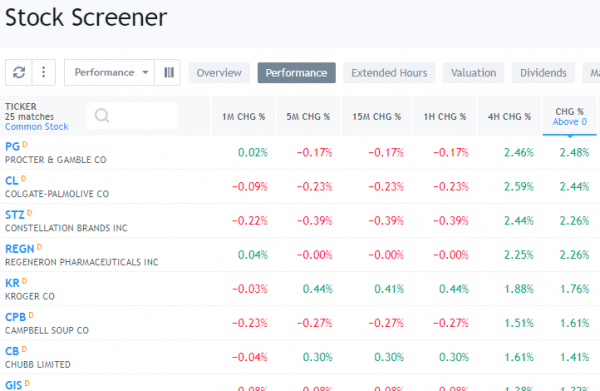
(Stock screening. Image: StockTrader)
Parameters to consider when applying your filters to a stock screener:
- Float – that is, the number of shares that are available to trade. Typically, you want the float to be below 100 million shares for a penny stock. When the stock has fewer shares to trade, there’s naturally more buying interest that could help drive up the price.
- Breaking news – Keep an eye on the news. Stocks that are gapping because of a news break could be lucrative for the company. Avoid stocks that have publicity from a buyout, however, as that can mean a breakeven result or a loss for the shares.
- Relative volume – a key parameter to keep an eye on since this indicator tells traders how the current volume of shares compares to previous trading volumes. The higher the relative volume, the more likely traders are watching and trading it, giving it enough liquidity for you to trade.
Use Financial Ratios
Financial ratios can be used in combination with other analysis tools to help determine the best penny stocks to trade. Penny stock companies with adequate financial disclosure will provide the best data to assess the worth of their stock.
Look for positive trends on the balance sheet and strong projected numbers as well as the following key ratios:
Liquidity ratios: An obvious one which when low, indicates that a company is either struggling to stay in business or to grow. To quantify liquidity, look at cash ratios, quick ratios and current ratios.
Leverage ratios: Highlight the ability of a company to pay its debt. Debt ratios will shrink and expand but should only expand if a company is in the midst of supporting future growth and development. Interest coverage ratios are key to determining a company’s debt load and its ability to manage it. High-interest coverage ratios are therefore preferable.
Valuation ratios: Identify the level of appeal of the stock at its current price. Be cautious here, since penny stocks can be undervalued. Price-to-sales and price-to-cash ratios are effective for valuing penny stocks.
Performance ratios: A good way to examine the amount of money made at each level of the income statement, which in turn should reflect either steady and sustainable growth or slow losses. Look at gross profit margin, net profit margin and return on assets.
Take a look at Stock Chart Patterns
Divide your stock analysis in two: fundamental and technical. Fundamental analysis largely uses information about the company itself, such as its debt management, growth capacity, lawsuits, revenues and contracts. Technical analysis, on the other hand, uses patterns on a trading chart.
A combination of both is always beneficial. It’s a good idea to start with fundamental analysis and move onto technical to gain a deeper insight into the underlying shares. But what exactly is technical analysis?
In short, it’s a trading strategy to evaluate investments and identify opportunities by analysing statistical trends such as price movement and volume. Upon focusing on price movements and volume, technical analysis tools scrutinise the way supply and demand for a security affect changes in price, volume and volatility.
The Relative Strength Index (RSI) measures the speed and change of price movements on a scale of 1 to 100. When it comes to penny stocks, RSI above 70 indicates that the stock is overbought or overvalued – which could suggest that a trend reversal or pullback is not too far in the future. In the same vein, RSI values of below 30 indicate that a stock has been oversold or undervalued – which may signal that the price correction is on the horizon.
Patterns to look for in your technical analysis
Whilst technical analysis is a vast discipline with many individual strategies and indicators at play, there are a few strong indicators to look for in your chart patterns. Keep in mind that these patterns are not infallible and should be incorporated into a larger strategy.
1. Price dips
We have already established that penny stocks are highly volatile due to the imbalance in buy and sell orders. Shares dip significantly when there are more sellers than buyers. If a stock drops without reason, on a low trading volume, this is a price dip pattern. Take advantage of price dips by identifying the penny stocks that are well below recent prices.
2. Bottoming out patterns
Bottoming out patterns emerge after sustained decreases in the share price. The trend may go downwards for several months and sideways for a few weeks. When this occurs in conjunction with an increase in trading volume, they will likely experience a sustained recovery in price.
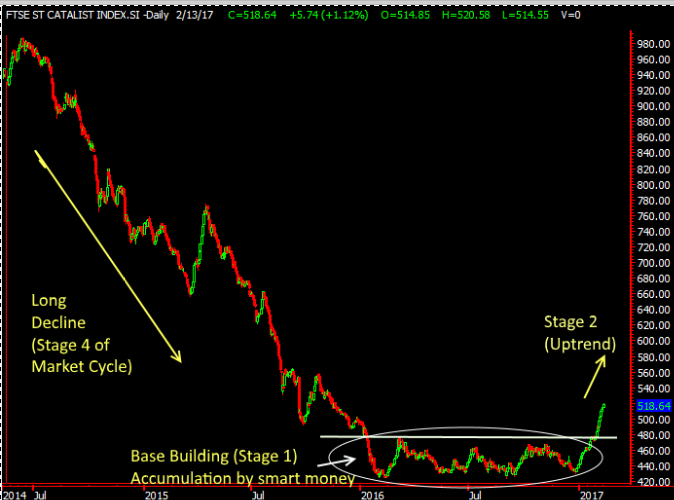
(Bottoming out the pattern. Image: Source)
3. Top-out patterns
Similar, in principle, to the former pattern; a top-out pattern will present shares that have been climbing for a long period of time, but appear to be levelling off. This could just be a short break, but in the case of a penny stock – particularly when it occurs during a declining daily trading volume – others may be preparing to move in on it.
4. Candlestick chart patterns
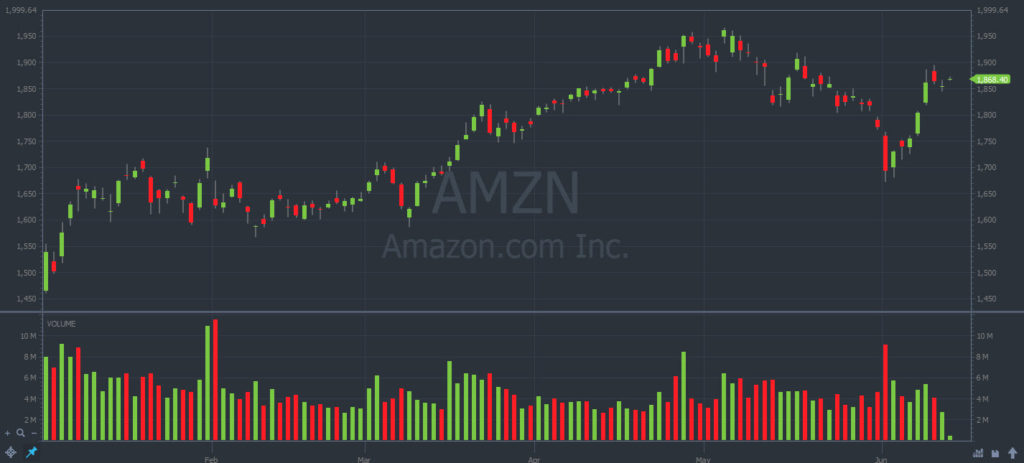
(Candlestick Chart. Image: StocksToTrade)
A unique and invaluable pattern to determine whether a penny stock’s trend is about to reverse or change. Candlesticks are created by up and down movements in the price. Bullish patterns indicate that the price is likely to rise, while bearish patterns fall. Candlestick patterns speak to investor psychology and are of no guarantee.
5. Gapping
A gap in the value of the stock occurs when it opens higher or lower than it did the day before. In large market exchanges, it’s not uncommon for a report to generate enough buzz to cause gapping. In penny stock trading, if a share gap is higher, it’s a bullish indicator and if it’s lower, it’s a bearish indicator.
6. Going against the trend
A reliable technical indicator for any type of stock share, but of particular use in penny stock trading. That’s because it has the capacity to identify stocks that perform well under pressure. For example, if the share’s you have your eyes on fall only slightly, or stays steady, whilst the rest of the market falls – that is a bullish and reliable indicator for your stock. Going against the trend is a wise way to invest in a bull market.
Minimizing Risk of Penny Stock Trading
Indeed, penny stocks make money. But they can also lose you a lot of money. Whilst they’re an incredibly risky investment, there are a few things investors can do to help minimise the risk and turn penny stock trading into a lucrative additional stream of income.
Go for tier one or two penny stocks. They’re monitored and reliable which reduces the risk of being manipulated. Avoid penny stock scams by keeping an eye out for the following red flags:
- Unofficial email promotions
- Boiler room telemarketing promotions brokers
- Anything labelled “hot tips”
- Online forum selling
Pump and dump schemes occur when promoters claim access to insider information in an effort to inflate prices of previously purchased low-cost lots – of which are subsequently offloaded for high profits. Don’t fall into the category of sorry investors who act on these tips and end up loaded with high-cost investments they’ll struggle to unload.
A variant of pump and dump; “short and distort” is when promoters short sell penny stocks at high prices and then strategically promote negative news about the stocks to lower the prices and square off their positions for high prices.
Avoid low liquidity penny stocks. You’re going to want to be able to cash in your stocks whenever you’re ready. Most penny stocks have volumes of a few thousands of shares a day. Penny stock companies with breaking news could have a high volume of millions of shares in a day. This is when you’re likely to cash in.
Consider the bottom line as follows: before you jump on the penny stock waggon, do your research, only risk what you can afford to lose, diversify your penny stocks and do everything you can to avoid being subject to scammers and manipulators.







![How Options Trading Works: The Ultimate Guide [2021]](https://daglar-cizmeci.com/wp-content/uploads/2020/12/Options-Trading-400x250.jpg)
